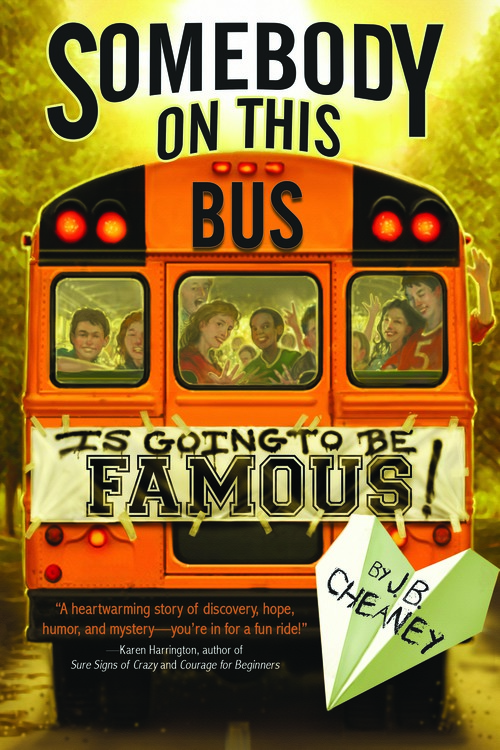J. B. Cheaney | The Children’s Book Review |September 9, 2014
Multiple Points of View? How about NINE?
 It’s my only novel that grew out of a title: Somebody on This Bus Is Going to Be Famous. Usually the title comes after I’m deep in the first or second draft, but this one popped right up and demanded a story. Obligingly, I started thinking. Suppose I had gone to school with some nerdy guy who turned out to be a comedy sensation on Saturday Night Live, or president of the USA? Or both? Or suppose I knew by some odd premonition that one of my classmates in Mrs. Nelson’s sixth-grade homeroom would be a world-renowned artist, but I didn’t know who? Or what if, instead of a classroom, I put the kids on a bus and let their stories unfold over the space of a year?
It’s my only novel that grew out of a title: Somebody on This Bus Is Going to Be Famous. Usually the title comes after I’m deep in the first or second draft, but this one popped right up and demanded a story. Obligingly, I started thinking. Suppose I had gone to school with some nerdy guy who turned out to be a comedy sensation on Saturday Night Live, or president of the USA? Or both? Or suppose I knew by some odd premonition that one of my classmates in Mrs. Nelson’s sixth-grade homeroom would be a world-renowned artist, but I didn’t know who? Or what if, instead of a classroom, I put the kids on a bus and let their stories unfold over the space of a year?
Who’s the famous one? I’m not telling—you’ll have to read the book.
I chose nine characters to tell the story because there are nine months in the school year: one for each month. Neat, huh? Some of them nudge the story forward a little more purposefully than others, but each of them is a “main character.” I didn’t know any children’s novels with more than four main characters, namely E. L. Konigsburg’s The View from Saturday and Lynne Rae Perkins’ Criss Cross. Was I in their league? Probably not, but it sounded like fun to try.
Each character has their own ambitions, struggles, and back story, but the main narrative thread involves a mystery that develops during the daily bus ride to school. Every morning during the fall semester, the driver turns off the highway to make a rural stop: a stop where nobody is waiting. Ever. Why she does this, and why she eventually stops doing it, is the mystery. And each of the characters holds a key, whether they realize it or not.
So how could I make this work? I’m usually not one for charts or graphs, but this story needed some chartery: first a calendar, showing each character’s month and story arc, along with what was going on with the others at the same time. Next a timeline of the chapters, showing where every character’s goal emerges and how those goals are developed, satisfied, or disappointed.
The main challenge in writing multiple points of view is helping the reader keep everybody sorted out. Because I was using one point of view per chapter, there were no sudden POV switches. But with so many primary characters, I had to make sure that as soon as Bender was mentioned readers would recognize him, and when Shelly spouted off they would know that’s exactly what she’d say. They would need some tags, such as relatable stereotypes to glom on to as they got to know these characters better. We often think in stereotypes—he’s the party animal, she’s the pushy career woman—and they can sometimes be helpful as long as we know when to let go of them. So I put a class clown on the bus, along with the bully, and the brain, and the jock, and the motherly introvert. I also tried to mention one outstanding physical characteristic early on, such as freckles, spectacular hair, a large head, or extra unwanted pounds.
Over time I was also able to develop subtle distinctions in writing style for each chapter. Though the narrative is all in third person, the ambitious idea girl thinks fast, with lots of exclamation marks and run-on sentences. The brainy kid uses a slightly upscale vocabulary. The future rock star thinks in italics.
All this helps readers recognize my characters and stick around to watch them grow into real, individual personalities. But that left the biggest challenge of all: I had to introduce all but one of them in the first chapter. How many middle-grade readers would tolerate fifteen new names tossed at them (not just protagonists but moms and little brothers and a bus driver) in a mere eleven pages?
My first presentable manuscript was turned down several times—a sign that even adult readers weren’t going to sit still for all those introductions. But then, inspiration struck: the story climaxes in a bus wreck. What if I moved the wreck to the beginning of the novel, showing only the bare, news-broadcast version and identifying no one except a highway patrolman? Then skip back in time to where the kids are boarding that same bus on the first day of school, with no clue what’s going to happen to them? The reader knows a wreck is coming; but what happens to each of the kids on the bus? That’s something they’ll have to pursue through the next 290 pages, and here’s hoping they stay on board for the whole ride.
About the Author
J. B. Cheaney is the author of five books for children and young adults, including The Playmaker, The True Prince, and My Friend the Enemy. The Middle of Somewhere was a nominee for the Texas Bluebonnet Award, the Florida Sunshine Young Readers Award, and the Young Hoosier (Indiana) award. Her latest title, Somebody on This Bus Is Going to Be Famous, is a Junior Library Guild selection for fall 2014.
 Somebody on This Bus Is Going to Be Famous
Somebody on This Bus Is Going to Be Famous
By J.B. Cheaney
Who’s it going to be?
Spencer’s the smart kid. Shelly’s the diva. Miranda’s the scaredy-cat. Matthew’s just average (so far). In fact, there’s nothing about any of the nine middle-schoolers on Mrs. B’s bus route that screams “fame.” But before the end of the year, somebody on this bus is going to be famous.
Every morning, their school bus waits at an empty bus stop. Nobody ever gets on. Nobody ever gets off.
And Mrs. B refuses to answer questions about it. Strangest of all, it’s Bender the bully who decides to investigate the mystery. But it will take all nine students to find out the truth, for each of them has a clue to the mystery that will change their lives forever.
Award-winning author J.B. Cheaney’s new middle grade novel weaves nine distinctive narratives into one fascinating read. Part detective story, part tale of self-discovery, this funny and touching novel is destined to be a modern classic.
Ages 10-13 | Publisher: Sourcebooks Jabberwocky | Sept. 2, 2014 | ISBN-13: 978-1402292972
For more book writing tips, follow along with our “Writing Tips” tag. And discover more books for middle graders by following along with our “Middle Grade Books” tag.

